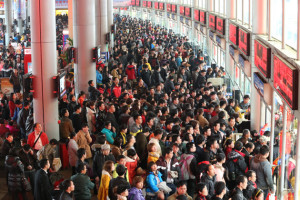Mass of humanity on the move
 It is the world’s largest annual migration and it doesn’t involve birds or wildebeest.
It is the world’s largest annual migration and it doesn’t involve birds or wildebeest.
When more than 200 million migrant workers in China’s industrial cities return home to their villages each spring the nation’s transport infrastructure is stressed to breaking point.
The Spring Festival, or Chunyun period, begins fifteen days before the Lunar New Year’s Day and lasts for around 40 days.
During this time workers in urban areas are usually given around 7-to-10 days off from their demanding jobs in the city to enjoy a temporarily more relaxed rural lifestyle.
Tracy Huang, contract and system analyst at Melbourne-based settlement AMES, moved from her home town of Fujian in China to Australia in 2003.
Like many other Chinese people, moving overseas hasn’t stopped her from returning home for the festivities whenever she gets a chance.
“I go home to Fujian about every two years for the festival to see my parents and old friends,” said Tracy.
“It’s like a combination of Western New Year’s Eve and Christmas. There is lots of eating, drinking and fireworks.”
Fireworks first blast off on New Year’s Eve and then continue for 15 days, until the official end of the season.
There are various traditions involved in the festival, such as young children being given money by their uncles, aunties, parents and friends.
“It’s particularly nice for big families to come together. There are dinners, parties and lots of celebrations,” Tracy said.
“There are other holiday periods during the year where people get three to five days off but that time is used for travelling. Spring Festival is for spending time with your family and reuniting with childhood friends,” she said.
The celebration has grown to become the biggest movement of people on earth since economic reforms in the late 1970s created new work opportunities in larger cities.
According to the China Labour Bulletin there are now 260 million Chinese that have migrated from rural to urban areas in search of employment, often as their only way to support their families back home.
“Most people move to big cities to find jobs, but they work long hours so the festival is the only time of the year they get to go home,” Tracy said.
During Spring Festival the majority of those migrant workers make the trip to their home towns and villages through a frenzy of trains, buses, ferries, cars and planes.
Last year there was an estimated 3.6 billion journeys by Chinese people travelling to make it home for the celebrations, almost tripling China’s population of 1.3 billion.
“There is a crisis of transportation because everyone in the country is to trying to get to their home town,” said Tracy.
Rail transport in particular experiences the biggest challenge during the period.
Though China has invested billions of dollars into building the world’s largest network of fast-speed trains, according to Want China Times the rail lines can only accommodate 10% of Spring Festival travellers.
While getting home for the festivities sounds like even a sardine’s worst nightmare, the transport situation won’t deter people from continuing the tradition.
“It’s a warm time for families to be united together, forget about their jobs and enjoy each other’s company,” said Tracy, who will be making the trip home again next year.
Ruby Brown
AMES Staff Writer












